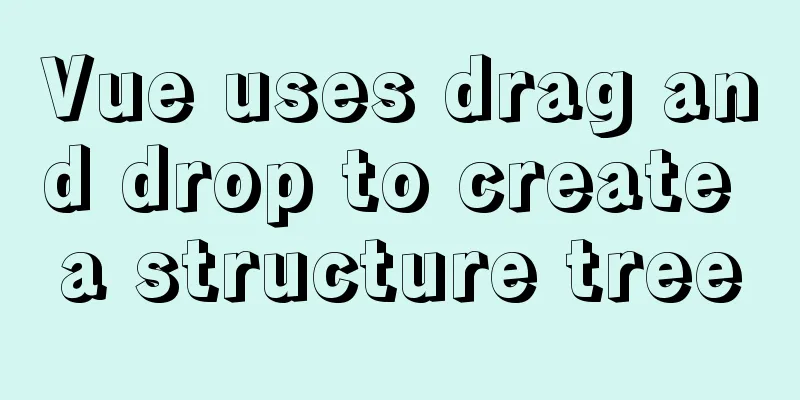Vue uses drag and drop to create a structure tree

|
This article example shares the specific code of Vue using drag and drop to create a structure tree for your reference. The specific content is as follows Drag the nodes in the dotted box on the page to create a right-facing structure tree, as shown below.
Record implementation ideas: vueTree.vue
<template>
<div class="container">
<div class="node-container">
<div v-for="(item, index) in nodeList"
:key="index"
class="source-node"
draggable="true"
@dragstart="dragStart(item)">
{{ item }}
</div>
</div>
<div class="tree-container"
@dragover="allowDrop"
@drop="handleDrop">
<tree-node v-if="nodeData"
ref="node"
:nodeData="nodeData"
@delete-node="deleteTree" />
</div>
</div>
</template>
<script>
import TreeNode from './treeNode.vue'
import { Node } from './config.js'
export default {
name: 'vue-tree',
components:
TreeNode
},
// Descendant nodes cannot obtain node data, that is, they cannot create nodes independently, so the node creation method of the ancestor node is exposed to the descendant nodes provide () {
return {
createNode: this.createNode
}
},
data () {
return {
nodeList: ['0', '1', '2', '3', '4', '5', '6', '7', '8', '9'],
currNode: null,
nodeData: null
}
},
methods: {
// Start dragging and get node data dragStart (item) {
this.currNode = item
},
// If the root node is not generated, dragging is allowedallowDrop (event) {
if (!this.nodeData) {
event.preventDefault()
}
},
//Drag ends, generate node handleDrop () {
if (!this.nodeData) {
this.nodeData = this.createNode()
}
},
createNode () {
let node = new Node(this.currNode)
return node
},
// Delete the root node and delete the entire tree deleteTree () {
this.nodeData = null
}
}
}
</script>
<style lang="scss" scoped>
.container {
padding: 20px;
width: calc(100% - 40px);
height: calc(100% - 40px);
.node-container {
height: 100px;
border: 1px dashed red;
display: flex;
.source-node {
width: 50px;
height: 30px;
background: #fff;
border: 1px solid blue;
text-align: center;
line-height: 30px;
margin: 10px;
cursor: pointer;
}
}
.tree-container {
height: calc(100% - 122px);
margin-top: 20px;
}
}
</style>config,js
export class Node{
constructor(name){
this.name = name,
this.children = []
}
}treeNode.vue
<template>
<!--
Structure: The outermost layer is node-inner. Each node-inner contains a node and a node-box. The node stores the current node, and the node-box stores all the child nodes of the current node. If the current node has several child nodes, there will be several node-ins in the node-box, and so on.
<node></node>
<node-box>
<node-inner>
<node></node>
<node-box>...</node-box>
</node-inner>
<node-inner>
<node></node>
<node-box>...</node-box>
</node-inner>
...
</node-box>
</node-inner>
-->
<div class="node-inner">
<div class="node"
:class="{ 'drag-over-node': isDragover }"
@dragover="dragOver"
@dragleave="dragLeave"
@drop="nodeDrop">
<span class="name">{{nodeData.name}}</span>
<span class="del"
@click="deleteNode">Delete</span>
</div>
<div v-show="nodeData.children.length > 0"
class="node-box">
<tree-node v-for="(item,index) in nodeData.children"
:key="index"
:nodeData="item"
@delete-node="deleteChild(index)" />
</div>
</div>
</template>
<script>
export default {
name: 'tree-node',
props: {
nodeData: {
type: Object,
default: () => { }
}
},
// Get the data passed by the ancestor node inject: ['createNode'],
data () {
return {
isDragover: false
}
},
methods: {
// The node allows dragging to add child nodes dragOver (event) {
event.preventDefault()
if (!this.isDragover) {
this.isDragover = true
}
},
dragLeave() {
if (this.isDragover) {
this.isDragover = false
}
},
// Add child nodes to the node nodeDrop () {
let node = this.createNode()
this.nodeData.children.push(node)
this.isDragover = false
},
// Delete the current node, which essentially means handing it over to the parent to delete the child node deleteNode () {
this.$emit("delete-node")
},
// Receive the instruction to delete the child node and execute the delete function deleteChild (index) {
this.nodeData.children.splice(index, 1)
}
}
}
</script>
<style lang="scss" scoped>
.node {
border: 1px solid orange;
border-radius: 4px;
position: relative;
display: inline-flex;
align-items: center;
justify-content: space-between;
background-color: #fff;
height: 36px;
padding: 0 12px 0 16px;
line-height: 36px;
margin-bottom: 10px;
.name {
font-size: 16px;
margin-right: 12px;
}
.del {
color: red;
font-size: 12px;
cursor: pointer;
}
&.drag-over-node {
box-shadow: 6px 6px 12px rgba(106, 20, 134, 0.15);
}
}
.node-box {
display: inline-flex;
flex-direction: column;
.node-inner {
margin-left: 80px;
// Connect the vertical bars&:not(:last-child):before {
position: absolute;
left: -70px;
top: 22px;
border: 1px solid orange;
content: "";
width: 8px;
background-color: #fff;
border-bottom-color: #fff;
height: 100%;
border-top-color: #fff;
z-index: 3;
}
// Connect horizontal bar&:after {
left: -61px;
width: 60px;
content: "";
position: absolute;
top: 14px;
height: 8px;
border: 1px solid orange;
content: "";
background-color: #fff;
border-right-color: #fff;
border-left-color: #fff;
z-index: 3;
}
// The last vertical bar has a rounded corner &:nth-last-child(2):before {
border-bottom-left-radius: 6px;
border-bottom-color: orange;
}
// The first horizontal bar is extended &:first-child:after {
left: -81px;
width: 80px;
z-index: 2;
}
}
}
.node-inner {
position: relative;
}
</style>The above is the full content of this article. I hope it will be helpful for everyone’s study. I also hope that everyone will support 123WORDPRESS.COM. You may also be interested in:
|
<<: Two ways to exit bash in docker container under Linux
>>: Analysis of the locking mechanism of MySQL database
Recommend
Linux remote login implementation tutorial analysis
Linux is generally used as a server, and the serv...
MySQL 8.0.16 installation and configuration tutorial under Windows 10
This article shares with you the graphic tutorial...
Detailed explanation of common methods of JavaScript String
Table of contents 1. charAt grammar parameter ind...
Vue scroll down to load more data scroll case detailed explanation
vue-infinite-scroll Install npm install vue-infin...
Detailed explanation of log processing of Docker containers
Docker has many log plug-ins. The default is to u...
Solution to the network failure when installing workstation in a virtual machine in ESXI
Problem Description After installing workstations...
Implementation of automatic completion of Docker commands
Preface I don't know how long this friend has...
PNG Alpha Transparency in IE6 (Complete Collection)
Many people say that IE6 does not support PNG tra...
20 excellent foreign web page color matching cases sharing
This article collects 20 excellent web page color ...
How to backup MySQL regularly and upload it to Qiniu
In most application scenarios, we need to back up...
Detailed steps for deploying Microsoft Sql Server with Docker
Table of contents 1 Background 2 Create a contain...
Using Docker+jenkins+python3 environment to build a super detailed tutorial
Preface: After the automation is written, it need...
Sample code for implementing the history tag menu using vue+elementui+vuex+sessionStorage
Generally, after there is a menu on the left, the...
MySQL data table partitioning strategy and advantages and disadvantages analysis
Table of contents Why do we need partitions? Part...
Analysis of MySQL crash recovery based on Redo Log and Undo Log
Table of contents MySQL crash recovery process 1....










